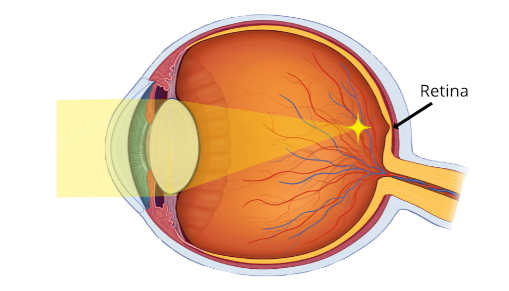Myopia, or nearsightedness, is quietly becoming one of the most pressing childhood eye health concerns of the 21st century. And it’s growing faster than most parents realize. According to recent research, by 2050, nearly half the global population could be myopic — a figure that raises major concerns for children’s future health, well-being, and quality of life.
Healthcare professionals are urging parents, caregivers, and teachers to recognize early signs of vision problems and take proactive steps to manage them.
What Is Myopia? And Why Is It Rising So Fast?
Myopia is a condition where nearby objects appear clear, but distant ones appear blurry. It occurs when the eye grows too long from front to back, causing light rays to focus in front of the retina instead of directly on it.

Once considered a condition largely affecting adults over 40, myopia is now increasingly diagnosed in children, especially in urban areas. Experts attribute this surge to:
-
Excessive screen time
-
Lack of outdoor exposure to natural light
-
Sedentary lifestyle and poor dietary habits
-
Genetic predisposition
“Every 3 out of 10 urban children require glasses today. High myopia — power over -5.00 D — poses long-term risk for retinal damage and vision loss,” says Dr. Manjula Jayakumar, Senior Consultant Paediatric Ophthalmologist.
Warning Signs of Myopia in Children
Recognizing myopia early is crucial. As children don’t always express visual problems clearly, watch out for these common symptoms:
1. Sitting Too Close to Screens or Blackboards
Children with undiagnosed myopia may sit very close to the television or digital devices, or ask to move closer to see clearly in classrooms.
2. Blurred Vision & Frequent Headaches
Unexplained headaches, especially after reading or screen use, may indicate visual strain.
3. Eye Strain and Rubbing
Excessive squinting, blinking, or rubbing of eyes can be signs of eye fatigue linked to poor distance vision.
4. Reading Habits
Many myopic children hold books or tablets too close to their faces or bend low while writing or sketching.
5. Behavioral Changes or Classroom Disinterest
A sudden disinterest in sports, attention issues in class, or irritability may stem from undetected visual discomfort.
“Behavioral signs are often missed. Early eye screenings help catch visual issues before they affect school performance or social behavior,” says Dr. Lav Kochgaway, Paediatric Ophthalmologist.
What Are the Risks of Untreated Myopia?
If left uncorrected, childhood myopia can progress rapidly, leading to:
-
Dependence on corrective lenses
-
Higher risk of retinal detachment
-
Cataracts, glaucoma, and other sight-threatening issues in adulthood
-
Reduced academic and social participation due to poor vision
According to Dr. Manjula Jayakumar, “Myopia is not just about wearing glasses. It becomes a lifelong burden if not addressed early.”
Causes: Genetics vs Lifestyle
While genetics play a role — children of myopic parents are more likely to be nearsighted — research also proves that environmental factors are modifiable.
“Children today spend less time outdoors and more time on close-up devices, accelerating the onset of myopia,” adds Dr. Sanchit Gupta, Eye Surgeon.
Key Lifestyle Factors Driving Myopia:
-
Prolonged screen time
-
Reduced outdoor activities
-
Poor lighting during reading
-
Unbalanced diet high in carbohydrates
How to Prevent and Control Myopia Progression
Myopia often starts in childhood — making early diagnosis and timely intervention essential. Fortunately, several options can help slow the progression of myopia:
1. Increase Outdoor Play
At least 90 to 120 minutes of daily outdoor activity can delay or prevent myopia onset.
“Sunlight helps regulate dopamine production in the retina and slows the eye’s axial growth,” explains Dr. Aloka Hedau, Pediatric Ophthalmologist.
2. Limit Gadget and Screen Use
Encourage screen breaks, use larger screens over phones, and follow the 20-20-20 rule — every 20 minutes, look 20 feet away for 20 seconds.
3. Use Myopia Control Solutions
Today, various clinically proven treatments are available:
-
Peripheral defocus glasses
-
Low-dose atropine eye drops
-
Orthokeratology lenses (Ortho-K) worn overnight to reshape the cornea
4. Regular Eye Exams
Begin screening at 3.5 years, especially if there’s a family history of myopia. Re-examinations should be done every 6 months.
“Early detection is the only way to manage the long-term complications of myopia,” stresses Dr. Ashwin Sainan, Pediatric Ophthalmologist, Hinduja Hospital.
How Parents and Schools Can Help
-
Promote outdoor education and sports
-
Educate children about maintaining good posture while reading
-
Ensure reading and screen environments have proper lighting
-
Avoid giving smartphones to younger children
-
Encourage hobbies that don’t over-rely on near vision
Spreading awareness and making eye health a family and community priority can go a long way in reducing this preventable condition.
Conclusion: Myopia Is Preventable, If We Act Early
Myopia in children is a growing global concern, but it’s not unstoppable. With the right awareness, lifestyle changes, and medical support, we can slow its progression — and in many cases, prevent its onset entirely.
Early intervention means giving your child the gift of clear vision, better academic performance, and a healthier future.